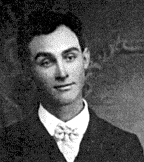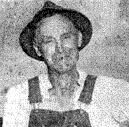THE PANTAGRAPH
1945
Thresherman for 57 Years
Recalls Old Time Machinery
Says Mortgage is Worst Thing About Farming
|


HEYWORTH --R. O. Halsey, six miles southwest
of Heyworth, finished his 57th threshing season a week
ago and now plans to retire to Clinton at age 70.
He started as water boy at age 13, then graduated to a
hand feeder of a threshing engine at 17, and for the
past 47 years has operated his own threshing machine.
Also, he has operated a corn sheller, once ran a
sawmill, and during that period he has accumulated over
500 acres of land.
The worst feature about farming is the mortgage, he
reflected, but you’ll never get anywhere at farming
unlessyou go into debt. He recalled the great relief
when his mortgage was paid, and also the black days of
the depression after the first world war, when the only
thing that saved his farm was that creditors didn’t
press for payments.
Horses on Engine.
A team of horses was used to guide that first steam
engine used when Mr. Halsey was a boy. The engine did
have a drive wheel coupling but no steering gear.
Mr. Halsey recalls that even before the steam engine
there were horse power threshers, with six teams of
horses hooked to the big beams, walking around in a
circle with a whipsnapper riding over the center gear.
He never worked with such an outfit but has seen them
in operation.
Hand Fed Threshers.
I was considered one of the fastest hand feeders in this
part of the country, he recalled, when telling how those
old threshers had to be fed by hand. Two pitchers would
pitch bundles from the wagons to the feeding table. Two
band cutters, with sharp knives, would cut bands by hand.
The safety rule in those days was that the band must be
cut with one slash of the knife -- never make a second
slash or you might cut the feeder’s fingers as he
snatched the loose bundles, to shove it, heads first, into
the thresher cylinder.
Many’s I time I hod those leather gloves slashed and
fingers cut, but I never lost a finger, he said.
Wages $20 a Month
Farm wages are now at an all time peak, Mr. Halsey
commented. He recalled that farm hand used to get only
$20. a month, but they were provided with meat and a cow,
eggs, all the garden space needed, and they’d go to town
only on Saturday nights. The farmer would provide the
horse and carriage to take the farm hand and his wife to
town once a week.
Hours were longer in those days. When he ran a steam
powered shelling outfit he would often arise at 2 a.m. to
get up steam, then haul the outfit 5 to 10 miles over
"not so good" roads and get the first loads of corn
shelled before sunup.
Have Had More Bugs
Yes, we’ve had far worse chinch bug years, he said. Near
failures of crops were recalled in some of those dry years.
The soft corn years of 1917 was a difficult one for
shellermen. The next spring many a rush order for shelling
was placed when blue smoke started coming out of the hot
corn stored in cribs.
The corn prospect this year is far from bad, although we
have had a dry summer, he reported.
'No, I’m not planning to retire to be a loafer,' he said.
He plans to come back to the farm often, to improve the
buildings a lot when supplies are available.
One observation was that the soil does seen to be washing
worse that ever. Fields that never did show gullies years
ago now need special protection to hold the soil at home.
It seems that our rainfall comes in heavier downpours than
years ago. Perhaps we’re having about the same amount of
rain each year but it seems to come in bunches, not in
many small showers.
|

